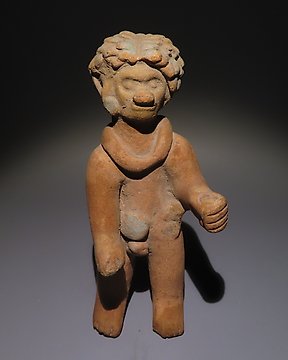
Jama-Coaque, Ecuador, Teracotă Figura. 12,5 cm. Licență de export spaniolă
Nr. 82728045

Nr. 82728045

Small Sculpted Vessel Dog
CULTURE: Teotihuacán, Mexico
PERIOD: 150 BC - 600 AD
MATERIAL: Terracotta
DIMENSIONS: Lenght 13 cm and Height 7 cm
PROVENANCE: A private Spanish collection established in the 1970s. With Spanish Export License.
PUBLICATIONS: The catalogue of the exhibition held at the Fundació Caixa Girona, “Ceràmiques dels déus”, pag 42, piece 4.
EXHIBITIONS: An exhibition at the Fundació Caixa Girona, “Ceràmiques dels déus”, 23 November 2006 to 14 January 2007.
CONDITION: The dog is intact apart from the right ear which has been reconstructed.
DESCRIPTION:
This piece is a sculpted vessel in bright brown -coloured terracotta. The animal is reclining and somewhat curled up. The forms are rounded and the piece has intentionally received a naturalistic treatment. The details have been worked with fine incisions, for example in the snout and the eyes, while the mouth suggests a faint smile. The whole piece transmits tenderness. There is a circular opening on the lower back so that liquids could be poured from this vessel when serving as a recipient in rituals.
Between the years 150 B.C. and 650 A.D., the period that covers the rise and fall of the city of Teotihuacan, various styles of pottery flourished which bear witness to the different activities of the inhabitants of this metropolis and of the interchanges that they carried out with other peoples, for example those in Puebla or Guerrero. These interchanges involved vessels both from the Mayan area as well as from the Gulf of Mexico and the west of the country.
The formal and decorative wealth of the Teotihuacan ceramic work reached its highest expression in the Jolalpan phase (350-550A.D.) thanks to the sophisticated techniques employed and the variety of designs – all bearing witness to the grandeur of this culture.
In the period we are dealing with styles of stucco painting began to be established, and this was applied to jars, vessels and cylinders. The wealth of colours and the variety of the designs stand out. These range from human and zoomorphic figures like dogs, to a wide variety of symbols and geometric forms that make these containers unique pieces.
BIBLIOGRAPHY:
- AA.VV, Sculpture of Ancient West Mexico, Los Angeles County Museum of Art, 1970.
- AA.VV, Trésors de la céramique précolombienne dans les collections Barbier-Mueller, 2003.
- VON WINNING, Hasso, Pre-Columbian Art of Mexico and Central America.
PARALLELS:
- National Museum of Archeology and Ethnology, Guatemala City.
- Los Angeles County Museum of Art, United States.
- Ethnological Museum in Berlin, Germany.
- National Museum of Anthropology, Mexico City.
- Amparo Museum, Puebla. Mexico.
Notes:
- The piece includes authenticity certificate.
- The piece includes Spanish Export License (Passport for European Union).
- According to Spanish legislation, items sent outside the European Union are subject to export taxes and will be added to the invoice, at the buyer's expense. These export fees are fixed on the final auction price and the tax rate is not applied directly on the total value of the item to be exported, but rather the different percentages by sections are applied to it:
- Up to 6,000 euros: 5%.
- From 6.001 to 60.000 euros: 10%.
This export permit application process can take between 1-2 months maximum.
- The seller guarantees that he acquired this piece according to all national and international laws related to the ownership of cultural property. Provenance statement seen by Catawiki.
THE MINISTRY OF CULTURE FROM SPAIN ASKS ALL SELLERS FOR INVOICES, IMPORT LICENSES AND ALL THE DOCUMENTATION ABLE TO PROVE THE LEGALITY OF EACH ITEM BEFORE PROVIDING AN IMPORT OR EXPORT LICENSE.
Cum să cumperi de la Catawiki
1. Descoperă ceva special
2. Plasează cea mai mare ofertă
3. Fă o plată sigură